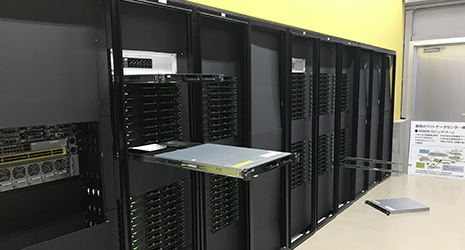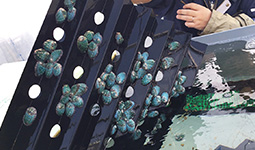INDEX
- English
- 日本語

Inside the White Data Center - English
- 日本語

White Data Center utilizes cleared snow to cool servers

Waste heat produced by the WDC servers during the winter is supplied to a greenhouse to maintain an internal temperature of 15 to 20 degrees Celsius 
Abalone farmed using waste heat from the WDC servers 
Komatsuna (Japanese mustard spinach) cultivated in a greenhouse
January 2022
Cooling Data Servers with Snow

For five years beginning in 2014, Bibai City in Hokkaido conducted the world’s first demonstration experiment in the use of snow to cool data servers. The city is now making efforts to extend these research results to commercialization of snow-cooled servers in data centers, and it is expected that these efforts will promote the regional revitalization of Japan's snow country.

Bibai City (population approx. 20,000 as of November 30, 2021), located in central Hokkaido, is an area of high snowfall, with up to 10 meters of snow accumulation every winter. Each year during the snowfall season, it costs the city 400 million yen (approximately 3.5 million US dollars at the exchange rate of January 20, 2022) to clear* and remove** snow to secure transport so that residents can continue to commute to work and school, and to prevent damage to buildings. Until recently, there was no effective means of reusing snow that had been cleared or removed at great expense, and it simply became a nuisance. Lately, however, measures are being established to collect, store, and effectively utilize that snow. One such measure entails the use of snow to cool servers in data centers.

The catalyst for this initiative was the Bibai Natural Energy Research Association, established by local volunteers in 1997. A research group with Professor Emeritus Kobiyama Masayoshi of the Muroran Institute of Technology as its technical adviser studied various ways of utilizing the coldness of snow as energy, referred to as snow cooling energy, such as in snow cooling facilities. Among these, the concept of a data center where servers are cooled by snow was proposed in 2008. Servers that handle vast amounts of data have been shown to generate high temperatures that, without intervention, can overload the server, causing it to fail and shortening its lifespan. To prevent this, the inside of the data center needs to be constantly cooled. However, the normal method of running air conditioning to cool data centers costs around the same as the electricity required to run the servers. The research group has been working to develop a technology which utilizes snow that has been cleared or removed as snow cooling energy for air conditioning.

As a result of demonstration experiments conducted over five years from 2014 and supported by funding from NEDO (New Energy and Industrial Technology Development Organization), a technology was developed to convert snow that has been cleared or removed together with mud, trash, and snow-melting agents, into energy that is then sent directly to a data center. This technology is said to cut cooling costs to less than half those of conventional data centers. Furthermore, a special feature is that the technology is 100% renewable with zero CO2 emissions. In response to this, White Data Center (below, WDC) was established in Bibai City and commercialization of the data center began in 2021. The center currently runs 20 racks of servers*** cooled by antifreeze**** fed through a pipe running from an artificial hill of snow collected by the city.

WDC President & CEO Ijichi Shinichi spoke about how the Center may develop. “The next data center we plan to build will be ten times the size of the current one, with 200 racks of servers running. In order to use energy efficiently, we’re experimenting with vegetable cultivation and fish and seafood farming in greenhouses using waste heat produced by the servers during winter. We plan to turn this into a reality as the data center grows in scale.”
Some 200,000 tons of snow are cleared or removed each year in Bibai City and the surrounding area. In the future, this could be used to cool 3,000 racks of servers. Bibai City is using snow as energy to run a data center, and even capturing the waste heat for use in agriculture and fisheries. There are high hopes for Bibai City’s example; namely, this special way to promote regional revitalization in Japan’s snow country.
* Snow clearing is the job of clearing snow from the road to make way for traffic.
** Snow removal is the job of loading snow onto a dump truck and transporting it to designated snow disposal areas.
*** Dedicated shelves for storing servers, router switches, and the like in data centers. Depending on the size of the servers and peripheral equipment, 20 racks might have data storage capability for around 40 companies.
**** Liquid used to prevent freezing in cold districts

